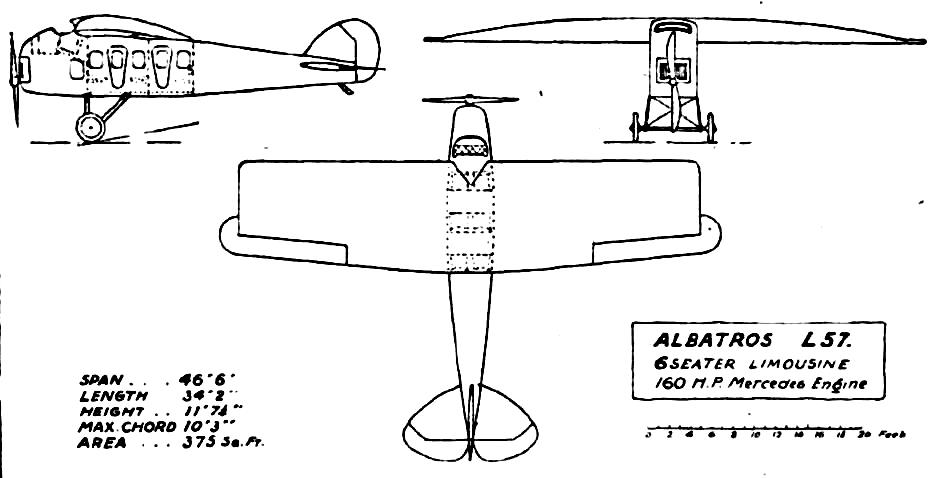AN ALBATROS COMMERCIAL MACHINE Flight December 1920
The " L . 57 "
AMONG the firms which have succeeded in getting their commercial types of aeroplanes passed by the Allied Commission has not hitherto, so far as one is aware, been the well-known Albatros Company. This firm, as is, of course, well known, is one of the German pioneer firms, but during the latter part of the War its products were somewhat overshadowed by those of other makers such as Junkers, Fokker, Zeppelin, etc. It now appears that the Albatros firm is making a bid for a prominent place among the makers of commercial machines, as several new designs have been got out recently. Among these is that shown in the accompanying scale drawings. In some respects this machine is not unlike the Fokker which recently paid a visit to this country, piloted by Mr. Hinchliffe. It is a cantilever monoplane, with the pilot and engineer placed in front of the wing, and the passengers housed in a cabin under the wing.
Thus the general arrangement follows that of the Fokker. In detail, however, marked departures are found. Thus the front cockpit is placed much higher in relation to the wing, and the top covering of the fuselage is swept up higher. As a matter of fact, the Albatros " L.57 " has its driver's seat placed not unlike that of the new " K " type 'buses, i.e., partly over the engine. The seats in this cockpit are tilted back, and the occupants sit with their legs quite horizontal This position, which at first sight might appear to be very uncomfortable, is, as a matter of fact, quite the reverse, as anyone can easily demonstrate for himself by sitting American fashion, with his legs resting on a table top. Being thus raised to a level with the top of the propeller tip circle the pilot certainly obtains a very good view forward, and as he is on a level with the leading edge of the wing his view to the rear and upwards and downwards is also fairly good. So far, the arrangement would appear to be a considerable advance over that of the Fokker, where the wing projects forward over the pilot's head, shutting off his view upwards, and, incidentally, causing a nasty swirling draught behind his head. In the Albatros " L.57 " the fairing behind the front cockpit is tapered off and is carried up over the nose of the wing. ,
The cabin, as already mentioned, is designed to accommodate six passengers, of which the two front ones sit facing aft, the remaining facing forward. Evidently the designer of the " L.57 " believes in ease of exit in case of emergency, as. he has provided two doors in each side. This arrangement, incidentally, has the advantage of avoiding the usual space between seats, no central gangway being necessary. The seats are so arranged that they can be easily removed and the cabin space used for cargo. The space available is 9 feet 3 inches long, 3 feet 10 inches wide and 5 feet 3 inches high.
The wing is of the cantilever type, and is chiefly remarkable on account of the way in which it is tapered. Apparently there is a slight negative dihedral to the leading edge, the " wash-out " to the tips being obtained in this manner, and not, as is more usual, by raising the trailing edge progressively from root to tip. In this respect the wing is somewhat reminiscent of the " Alula," but otherwise it appears to be entirely different. The thickness of the wing is a maximum of about 2 feet at the root, and> the space thus provided is made use of as a luggage compartment. The petrol tanks are mounted, one on each side of the fuselage, inside the wing, from where, presumably, it is possible to feed the petrol direct to the carburettor by gravity In the form shown in the accompanying general arrangement drawings the power plant is a 160 h.p. Mercedes. Other engines such as the B.M.W. or Benz can, however, be fitted if desired, and the following table shows the main weights, performance, etc., with the three different engines :-
| Type |
Project for an airliner 2 + 6. Ordered by the DLR and Deutscher Aero-Lloyd, probably never finished because of the "Bauverbot" 1920 to May 1922. |
| Engine |
1 Mercedes D IIIa |
| Dimensions |
Length 10.42 m, height 3.55 m, span 14.20 m, wingarea 34.50 m2, aspect ratio 5.84 |
| Weights |
Empty 1036 kg, fuel 156 kg, oil 18 kg, crew 80 kg, load 560 kg, flying weight 1850 kg |
| Performance |
Max. speed at sea level 149 km/h, cruising speed at sea level 120 km/h, climb 1.60 m/sec., to 500 m 4.9 min., to 1000 m 10.3 min., to 2000 m 26.5 min., to 3000 m 67.6 min., service ceiling 3450 m, range 540 km, endurance 4.5 h, landing speed 80 km/h |
